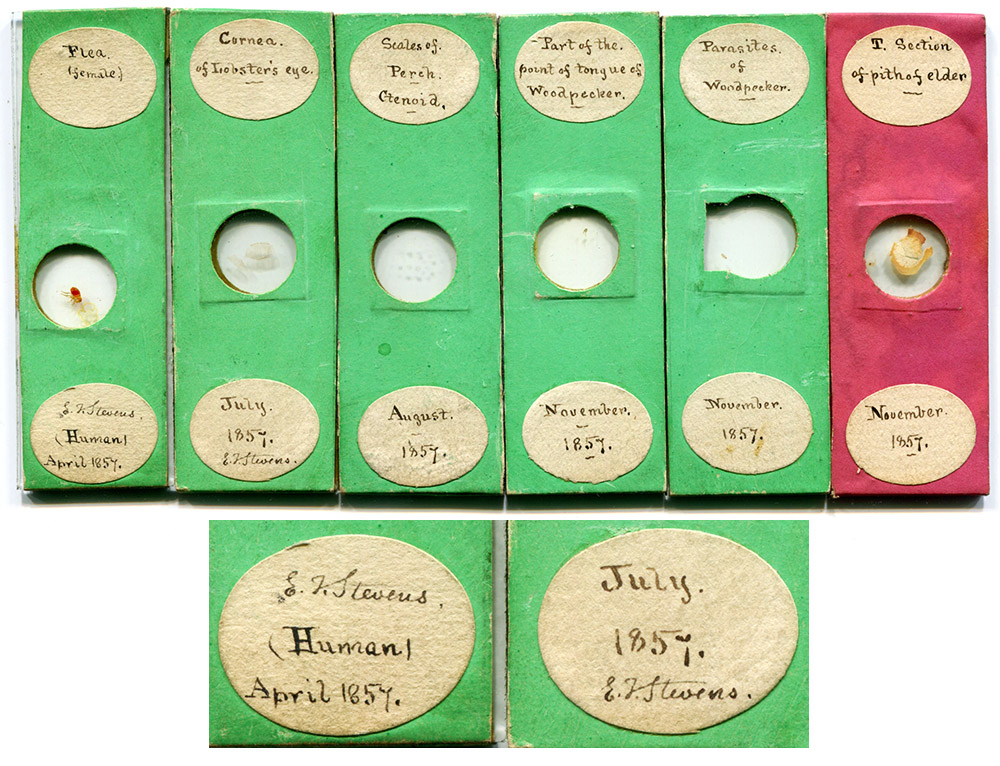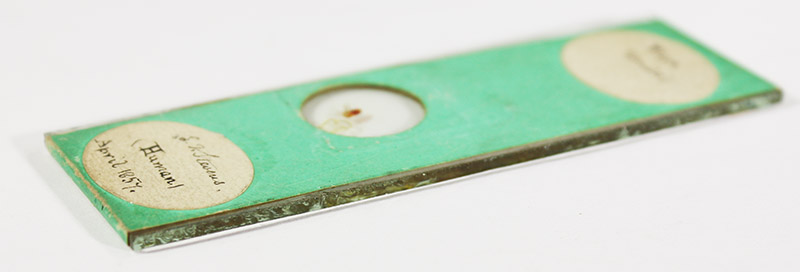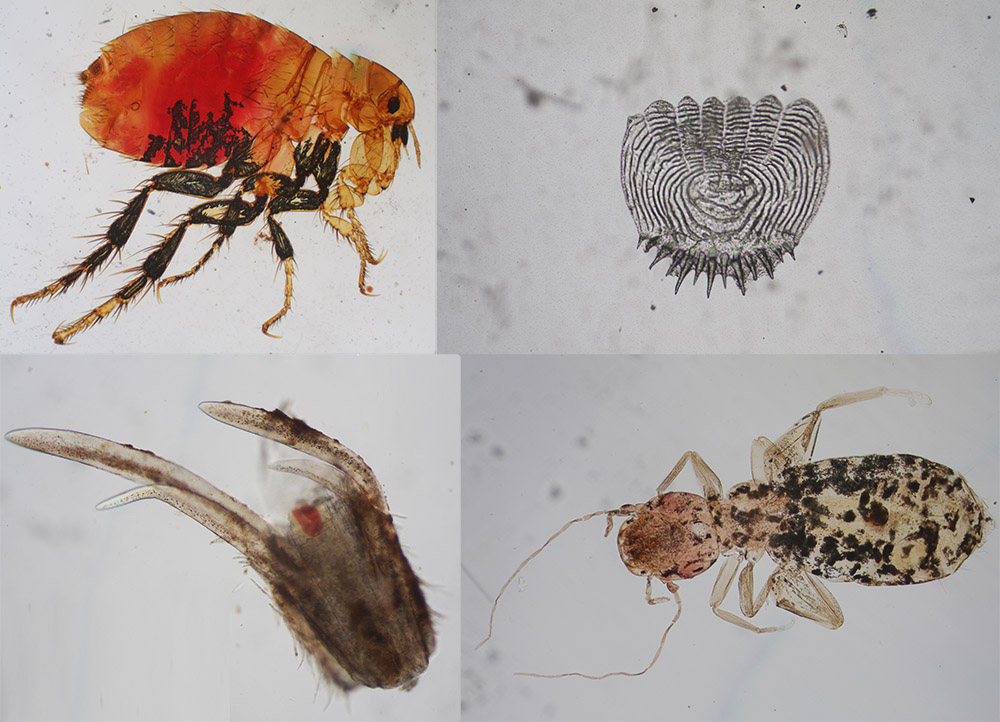
Figure 1. Examples of microscopes by E.T. Stevens, all dated 1857. The two on the far left include his name.
E. T. Stevens
probably Edward Thomas Stevens, 1832 - 1898
by Brian Stevenson
Last updated November, 2021
Signed and dated microscope slides from the 1850s and earlier are relatively rare. Slides that are signed by E.T. Stevens are seen on occasion, of which all known preparations are dated from 1857 (Figure 1). All show evidence of having been made by an amateur microscopist: the glass slides were hand-cut from larger sheets and have rough, sharp edges; the cover slips are irregular in shape, evidence of having been broken from larger sheets of thin glass; and the plain green or red covering papers are unevenly cut (Figures 1 and 2). Stevens shows evidence of having at least modest slide-maker skills, as a number of their preparations are mounted in Canada balsam.
Extensive searches suggest that microscopist E.T. Stevens was most likely to have been the Reverend Edward Thomas Stevens, a clergyman, teacher, and author of educational books. Stevens' numerous books reveal that he was well-versed in the use of microscopes.

Figure 1.
Examples of microscopes by E.T. Stevens, all dated 1857. The two on the far left include his name.

Figure 2.
Side-view of a Stevens microscope slide of a human flea. Note that the edges of glass slide are uneven and sharp. A professional slide-maker would have either smoothed the edges with emery or a file, or would have covered all four edges with protective paper.
Edward Thomas Stevens was born in Suffolk, England on October 21, 1832, son of Edward and Hannah. At the time of Edward Thomas' 1853 marriage to Hannah Cooper, his father was employed as a "clerk of works". Young Edward was then working as a "schoolmaster" in Halifax, Yorkshire. By 1860, he and Hannah had moved to Islington, Middlesex, where he again worked as a "schoolmaster".
The title pages of Stevens' books indicate further moves. In early 1866, he was an Associate of King's College, Oxford (Stevens earned an M.A. in Divinity from Oxford). Later in 1866, he was headmaster of Cathedral Grammar School, in Bristol. During the later 1860s – early 1870, he became Chaplain of New College, Oxford. Around 1874, he assumed the Vicarship of Sibford Gower, Oxfordshire. He died there on October 15, 1898.
Edward Thomas Stevens' educational books indicate that he was very familiar with microscopes and preparing objects for examination. Some excerpts:
From his 1868 The Complete Reader, Book IV: The Senior Reader, "Microscopical Examination of the Hair. - If a hair be drawn between the finger and thumb, from the end to the root, it will be distinctly felt to give a greater resistance and a different sensation to that which is experienced when drawn the opposite way; in consequence, if the hair be rubbed between the fingers, it will only move one way (travelling in the direction of a line drawn from its termination to its origin from the head or body), so that each extremity may thus be easily distinguished, even in the dark, by the touch alone. The mystery is resolved by the achromatic microscope. A hair viewed on a dark ground as an opaque object with a high power, not less than that of a lens with one-thirtieth of an inch focus, and dully illuminated by a cup, the hair is seen to be indented with teeth somewhat resembling those of a coarse round rasp, but extremely irregular and rugged: as these incline all in one direction, like those of a common file, viz. from the origin of the hair towards its extremity, it sufficiently explains the above singular property This is a singular proof of the acuteness of the sense of feeling, for the said teeth may be felt much more easily than they can be seen. We may thus understand why a razor will cut a hair in two much more easily when drawn against its teeth than when drawn in the opposite direction."
From the 1873 Useful Knowledge Reading Books, "The next day Annie was examining the wing of a fly under a microscope, and was astonished and delighted at its extreme beauty."
From the 1876 Domestic Economy for Girls, "Butter - Suppose your power of sight were suddenly increased, so that, with the naked eye, you could see things that are now visible through the microscope only, and suppose with these finer eyes you set to work to examine a glass of milk. Instead of the delicious white fluid you know so well, you would see a clear bluish liquid, full of floating balls of oil; each covered with a delicate skin of curd, and so exceedingly small that thousands of them could find room in a teaspoon, without jostling their neighbours or cracking each other's delicate skins. If you watched carefully you would soon see, provided the milk was not disturbed, these balls rise by thousands to the top of the milk, until at length they covered it with a rich yellowish crust. took some of this rich substance and shook it steadily for some time, all the delicate curd-skins would break, the oil would flow together and presently form lumps of delicate yellow fat. If you carefully separated this fat from the curd-skins and the milk mixed with it, as you could easily do by washing it in spring water and kneading it carefully, you would find your oil globules changed into tempting golden butter."
and
"Next day Mrs. Richards came into Ellen's room with a microscope, a wisp of wool out of the pasture, a bit of fur, and a hair or two from her own head in her hand. 'I promised to tell you about the saw-like teeth to be found on the exterior of all hairs, and now you may amuse yourself by examining these through the microscope. On the curly, crisp, wool fibres, Ellen could distinctly see that the coating consisted of layers of tiles or scales in rings from the roots to the point, not unlike those on a serpent's skin. They were not quite so discernible on the other hairs, but her mother told her they only required a stronger microscope. This she showed by just passing her finger along the hairs. When drawn from root to point they yielded to the finger, but when moved in a contrary direction, the scales caused them to present a strong resistance."

Figure 3.
Some of the specimens that were mounted by E.T. Stevens during 1857 (see Figure 1). Clockwise from upper left: "flea, female, human", "scale of perch", "parasite of woodpecker", and "part of the point of tongue of woodpecker". Of note, the "parasite" from the woodpecker is not a parasitic louse, but is instead a book louse (Psocoptera, now Psocodea). Book lice are common pests of museum collections, so it is possible that Stevens mounted this one from a preserved woodpecker. The flea was photographed with a 3.5x objective lens, and the other specimens with a 10x objective, all with a C-mounted digital SLR camera on a Leitz Ortholux II microscope.
Acknowledgement
Thank you to Tom Schwan for correcting the identity of Stevens' "parasite".
Resources
England census and other records, accessed through ancestry.com
Marriage record of Edward Thomas Stevens and Isabella Hannah Cooper (1853) Parish records of St. James, Halifax, Yorkshire West Riding, accessed through ancestry.com
http://sites.rootsmagic.com/StCatz/individual.php?p=210 (accessed November, 2021) Rev Edward Thomas Stevens M.A. Oxon
The Sibfords (accessed November, 2021) Reverend Edward Stevens, https://thesibfords.uk/about/people/stevens
Stevens, E.T. and C. Hole (1866) The Advanced Lesson Book, Longmans, Green & Co., London
Stevens, E.T. and C. Hole (1866) The Complete Reader, Book II: The Intermediate Reader, Longmans, Green & Co., London
Stevens, E.T. and C. Hole (1868) The Complete Reader, Book IV: The Senior Reader, Longmans, Green & Co., London, page 260
Stevens, E.T. and C. Hole (1873) The Useful Knowledge Reading Books, Longmans, Green & Co., London, page 21
Stevens, E.T. (1876) Domestic Economy for Girls, Longmans, Green & Co., London, pages 20 and 218-219